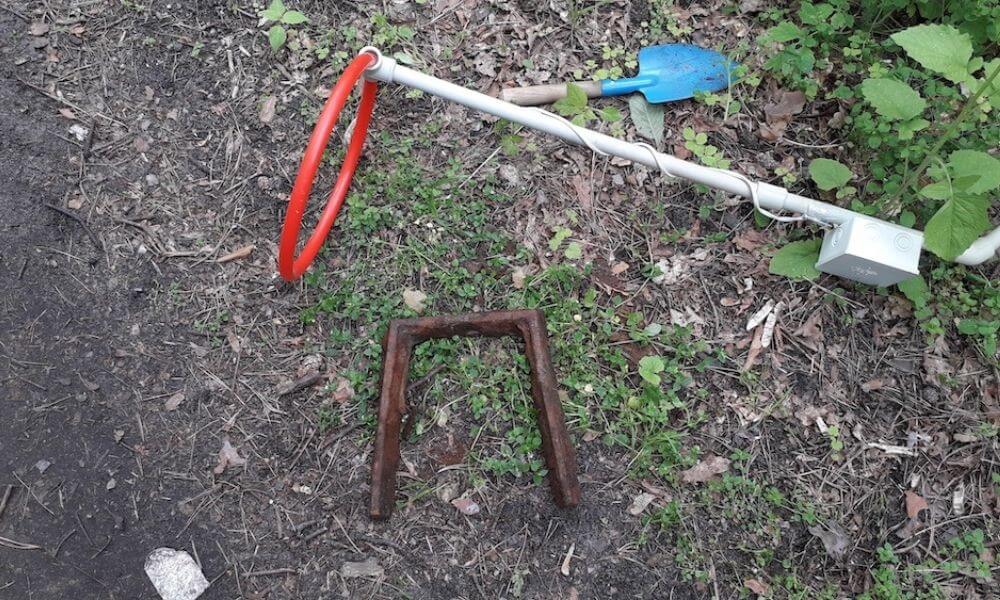A metal detector is a tool you can use to find metal objects underground.
Each metal object carries a certain value, depending on the rarity of the metals themselves.
Below is a chart of various metals and their value:
| Valuable Metals | Low-Value Metals |
| Gold, Silver, Bronze, Aluminum | Iron, Nickel, Lead, Zinc |
Reasons to Use a Metal Detector
There are two specific reasons to use a metal detector
To Find Treasure: There are plenty of valuable metals underground. Certain metals fetch a good market price, such as silver, aluminum, and gold. However, there are junk metals such as iron, which are quite commonplace and hold little value.
To Find a Septic Line: Septic tanks hold your wastewater. Sometimes you need to check if the tank is full to avoid potential spillage. To find a septic tank with a metal detector, you can search for the steel top. Your metal detector should locate this specific metal, which makes it easier to find.
On What Principle Does a Metal Detector Work?
The main working principle of a metal detector is magnetism, which refers to physical force by electric charges.
Due to the electric charges from the magnetic field, they create both attraction and repulsion of objects. Metal detectors use magnetism to find underground objects easier.
All metal detectors have a transmitter coil at the end. The coil transmits an electromagnetic field; any metallic objects within that range can be found.
When in use, the metal detector sweeps over the ground. The electricity within the coil gives a magnetic field within your area.
As you search for underground objects, the metal detector picks up electric activity. When nearby metals are found, the electric coil makes a loud beeping signal.
These signals let you know if the object is close by. The stronger the sound effects are, the more likely a metallic object is below the surface.
How Do You Read A Metal Detector?
To read a metal detector, you need to understand both target identification and the different beeps your device makes.
Target identification refers to the metal you find. Another term to know is VDI, which is the Visual Discriminator Indicator.
The VDI allows you to only look for specific metals based on conductivity. Your metal detector uses electromagnetism to determine the electrical flow of nearby objects.
Every object gives off different levels of conductivity. It makes it easier to identify targets since you can classify specific metals into categories.
Here is an example from a Minelabs device, which features coins and their VDI:
| Metal | Target ID Number | Value |
| U.S. Nickel | 13 | Low |
| Zinc Penny | 21 | Low-Medium |
| Copper Penny | 25-26 | Low-Medium |
| Silver Dime | 26-27 | Medium |
| Silver Dollar | 38 | High |
Keep in mind different manufacturers use their personal number system. What is 21 on a Minelabs metal detector might be something else entirely with Garrett, for example.
Your metal detector has a display screen that gives off numbers. The more expensive a product is, the more detailed the screen numbers are.
You can read off the numbers on the screen whenever you search for metals. These numbers only show up once an object is detected.
How Does a Metal Detector Work for Gold?
Gold is like any other metal in which you can find with electromagnetic readings. However, there are special gold detectors that use inductance and conductivity.
Inductance refers to eddy currents. In other words, they’re electric charges moving within a circular fashion. Their movements make it easier to identify.
Conductivity is the overall electric flow. A detector can measure the speed of the currents due to electromagnetism. These are also known as time constants.
A gold detector uses both inductance and conductivity to track down gold easier. Eddy currents carry a unique electromagnetic field, which makes them stand out.
The time constant of metals differ. While aluminum has short ones, gold has longer ones. Gold detectors are meant to recalibrate for better time calculations.
Gold detectors tend to be more expensive than their regular counterparts since gold is a more valuable metal for collectors to find.
What Is A Metal Detector Circuit?
A metal detector circuit refers to the three main components, as shown below:
- LC Circuit: The circuit forms electric charges needed for electromagnetism.
- Proximity Sensor: It lets you know the distance between you and any detected metals.
- Output LED and Buzzer: These are the visual and auditory indicators of the particular object you are trying to find. It displays numbers and makes beeping sounds.
Every metal detector uses these basic parts to find metallic objects. The circuit itself sends signals throughout the coil transmitter.
What Is Metal Detector Frequency?
Metal detector frequency refers to a measure of frequency in kilohertz or kHz. Metal detecting relies on frequency to find specific objects of a similar electric wavelength.
The easiest frequency to use for beginners is anywhere between five kHz to 15 kHz. The vast majority of regular metal detectors are finely tuned to use this frequency.
You can use 10 kHz to find metallic coins, such as silver dollar ones. Coins are useful resources for metal treasures, depending on the current market value.
Low frequency often has long wavelengths, which allows them to locate objects deeper underground. By comparison, higher frequency do not.
As a result, low frequency is the more recommendable setting to use, especially if you want to look deep below the surface.
What Metals Cannot Be Detected By a Metal Detector?
Certain metals cannot be detected if they carry a low frequency for electric charges. If an object has a low magnetic pull, it makes it more difficult for a detector to find them.
The environment plays a key role in your search, such as the position of objects below the ground. Obstructions can also get in the way of you and the object.
Below are underground objects not likely to be found with a metal detector:
- Stainless steel
- Diamond
- Pearls
- Gemstones
- Paper
- Bones
- Stone
A metal detector is meant to find valuable objects such as aluminum, silver, and gold. Despite their rarity, a metal detector has an easier time looking for these objects rather than the above.
How Far Can Metal Detectors Detect?
The average metal detector can find underground objects at least 10-20 centimeters deep.
How deep a metal detector works relies on multiple environmental factors. You need to take into consideration the following:
- What is the depth of your metal detector?
- What is the size and shape of the object you look for?
- What are the materials that make up the ground?
Higher-priced models detect objects much deeper below the ground. However, the success rate of finding objects depends on being aware of your surroundings.
To find a specific object, use your Discrimination setting on your metal detector. You can decide which metals you want to look for based on a particular value.
Where Are The 15 Best Places to Use A Metal Detector?
Below are the 15 best places to use your metal detector:
- Abandoned Areas: Former residents often leave behind objects.
- Beaches: Washed-up materials end up in these locations.
- Campgrounds: You can find common metals left in this area.
- Open Fields: Farmlands offer a good hunting ground.
- Swimming Holes: You can find natural and organic metals here.
- Footpaths and Trails: Hikers can leave behind metal objects
- Parks: Due to the heavy population, someone is bound to drop something here.
- Forests: In rare cases, you might find rare metals left untouched by settlers.
- Gardens: Agriculture fields offer unique locations for metal gathering.
- Historical Sites: If you can, you can find tons of rare treasure.
- Battlefields: These areas leave behind broken scraps of weaponry.
- Churchyards: Such locations tend to be of historical significance.
- Ghost Towns: Similar to abandoned properties, you can find objects left behind.
- Circus Routes: Since these are hard to find, you have a better chance with rare pick-ups.
- Landmarks: Since many people visit these locations, they may end up leaving behind metals; these also serve as historical landmarks.
No matter which location you choose, always be mindful of what you’re looking for.
What Are The Best Metal Detector Brands?
The best metal detector brands are dependent on three factors, which are weight, durability, and ease of use. These three factors determine how well you can handle a metal detector.
Weight: The lighter it is, the easier it is to pick up.
Durability: Your metal detector needs to withstand pressure for long-term usage.
Ease of Use: How simple is it to understand the controls.
For the sake of simplicity, you should consult a list of the best metal detectors. Below is a list of the best metal detectors brands:
| Brand Name | Weight | Durability | Ease of Use |
| Minelab Equinox | 5/5 | 4/5 | 4/5 |
| Garrett AT Pro | 4/5 | 4/5 | 5/5 |
| Nokta Makro Simplex | 4/5 | 3/5 | 5/5 |
| XP ORX | 4/5 | 4/5 | 5/5 |
No matter which brand you use, be sure to weigh in your options carefully. Every metal detector is built differently, so use the one you’re most comfortable with.



